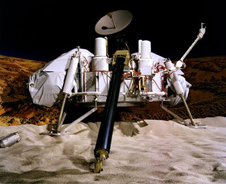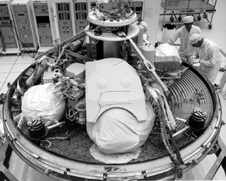September 30, 2010 Vol. 3, Issue 9
NASA successfully put the second Viking lander on Mars in September 1976.

Image of deployed Viking Lander. Credit: NASA
Thirty-one seconds later than expected, Viking 2 landed on the surface of Mars with the grace “of a motorcycle dropping two feet on Earth,” wrote New York Times reporter Walter Sullivan. After a loss in communications due to a temporary shutdown in the orbiter’s stabilization system, the tense atmosphere at the Jet Propulsion Laboratory in Pasadena, California, broke after the first return communications. “A shout went up in the control room here,” wrote Sullivan, “followed by wild gesticulations.”
Viking 2 was one of a pair of identical spacecraft that conducted the first successful landings on the Martian surface. The Viking 2 lander was a 1,270-pound, six-sided aluminum craft supported by three legs. It carried a number of scientific instruments to study atmospheric composition and meteorology, geologic activity, and surface and soil samples.
In the wake of the Mariner missions to Mars, the search for signs of life was paramount. The instrument responsible for finding evidence of life in the soil was the gas chromatograph-mass spectrometer (GCMS). Developing a GCMS for the billion-dollar Viking project proved very challenging. During the early seventies, Dr. Klaus Biermann of MIT, leader of the molecular organic analysis team, had a GCMS the size of a room—its operator could literally walk through it. The instrument for Viking needed to be the equivalent of a 15 kg hatbox.
For several years, the GCMS topped Viking project manager Jim Martin’s “Top Ten Problems” list. Martin managed to remove the GCMS from his Top Ten Problems list in May 1975, just weeks before the first Viking launch. (Read the case study.)

Technicians inspect the Viking Lander 2 in KSC’s Spacecraft Assembly and Encapsulation Facility #1. Credit: NASA
Both Viking spacecraft completed a 333-day journey to Mars. Viking 1 launched on August 20, 1975, arrived at Mars on June 19, 1976, and landed on the surface on July 20, 1976. Viking 2 launched on September 9, 1975, reached Mars on August 7, 1976, and landed on its surface on September 2, 1976. Together, the two landers showed the world the first images of volcanoes, lava plains, canyons, craters, wind-formed features, and hinted at evidence of surface water from the ground of the Red Planet.
The landers were powered by two radioisotope thermal generator (RTG) units, which generated electricity from heat given off by the natural decay of plutonium 238. Each generator provided 30 watts of continuous power at 4.4 volts. These generators provided the long-term power to enable science investigations that would not have been otherwise possible.
Similar to the twin Mars Exploration Rovers that followed in their footsteps, the Viking spacecraft went above and beyond the call of duty. Scheduled to operate for only 90 days after landing, both the landers and orbiters significantly outlived their life expectancies. The Viking 1 lander ended communications on November 13, 1982, and the Viking 2 lander ended on April 11, 1980. The Viking 2 orbiter was turned off on July 25, 1978 after developing a leak in its propulsion system that vented its attitude control gas. It returned nearly 16,000 images in approximately 706 orbits around Mars.
Read Searching for Life on Mars: Development of the Viking Gas Chromatograph-Mass Spectrometer.





